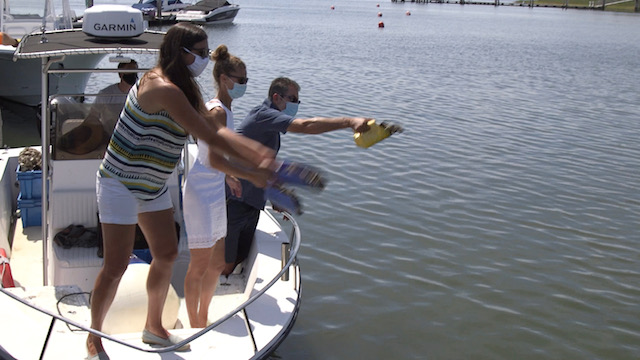Back in 2018, Gurney’s Star Island Resort partnered with Cornell Cooperative Extension Marine Program (CCE) to enlighten visitors of the Montauk property about marine science based education and shellfish restoration.
“With maritime culture being an integral part of our DNA, we aim to thoughtfully engage in sustainable practices within water quality, habitat, aquaculture and STEAM – all of which are very important to our community,” noted Owner of Gurney’s Resorts, George Filopoulos. “Last summer, we successfully partnered with Cornell Cooperative Extension Marine Program to deliver a custom youth education program involving those practices and this year we are honored to once again collaborate with CCE to support the marine environment and educate our guests about the importance of protecting our waters.”
 |
|
The CCE team prepare the Oyster Reef for its new home in Lake Montauk. (Courtesy Photo) |
Through CCE’s “ArtSEA” Art + Science integrative projects, the Gurney’s Kids Club offers hands-on marine science education. The Montauk resort also hosts CCE’s FLUPSYs (floating upweller system) that is capable of championing the growth of millions of clams and oysters, which is incredibly beneficial to local shellfish restoration efforts.
Most recently, Gurney’s Star Island Resort & Marina, Cornell Cooperative Extension Marine Program and Concerned Citizens of Montauk (CCOM) joined forces on a new Spat-on-shell Oyster Reef.
“CCOM is thrilled that CCE’s shellfish restoration experts have teamed up with Gurney’s, a local business who is serving as steward of our environment, doing their part to improve our local waters. I cannot wait to see how this project develops and expands over the years,” stated Laura Tooman, President of Concerned Citizens of Montauk.
We caught up with Kimberly Barbour, CCE Marine Program Outreach Manager, to find out more about this incredible endeavor.
How did the region’s first-ever Spat-on-shell Oyster Reef come to be?
KB: Cornell Cooperative Extension Program has been working to deploy spat-on-shell Oyster Reefs for years in the waters around Long Island, this is just the first of its kind in Lake Montauk/Montauk area in general. This came to be because of Gurney’s Star Islands desire to help give back to our waters and after evaluating the site we determined it would be a great candidate location for a spat-on-shell Oyster Reef. With support from Gurney’s Star Island, we spawned oysters in our hatchery in Southold, NY, set the larval oysters on recycled oyster shell and then delivered and planted them on site at Gurney’s Star Island’s Marina, which is the largest in the Hamptons and located on Lake Montauk.
The Oyster Reef was deployed – placing approximately 100,000 Spat-on-shell oysters on the bottomlands offshore of Gurney’s Star Island which is located on Lake Montauk – on Monday July 27. How long did that process take and what did it entail?
KB: It’s actually a rather quick process with our team of experts and technicians we were able to get all of the spat-on-shell planted in less than an hour!
 |
|
The CCE team in action. (Courtesy Photo) |
Gurney’s Star Island Resort & Marina, Cornell Cooperative Extension Marine Program and Concerned Citizens of Montauk plan to expand the reef annually. What’s the goal?
KB: We have a permit in place from NYSDEC that will enable us to deploy 100,000 spat-on-shell oysters per year for 10 years, with a potential to expand beyond that but for now, we are hoping to work with Gurney’s Star Island and community supporters to enable approximately 1 million oysters to thrive at this location by 2030.
Could you discuss the benefits of having the Oyster Reef in Lake Montauk?
KB: The juvenile spat-on-shell oysters will continue to grow on to adults that are capable of filtering up to 50 gallons of water per day, helping to remove excess nutrients from the water column and improving water quality and clarity. The 3D structure the oyster reef forms on the bottom serves as excellent habitat for fish and invertebrates, and the addition of these oysters will help enhance local oyster populations as the spat-on-shell reaches maturity and spawns during their lifecycle.
For more information, visit www.backtothebays.org.












